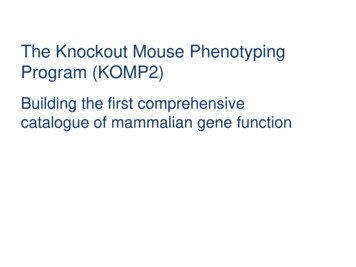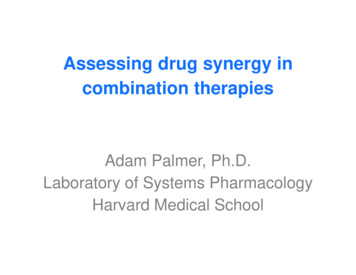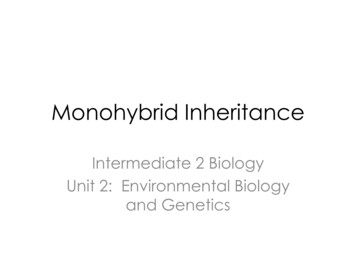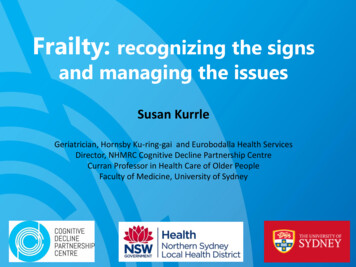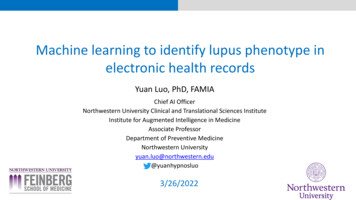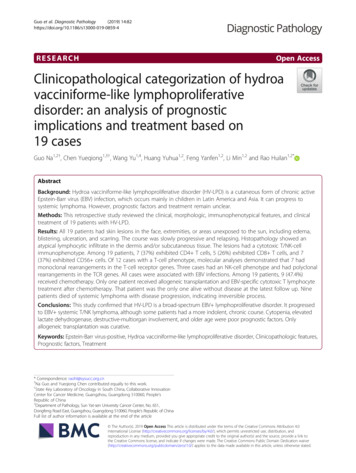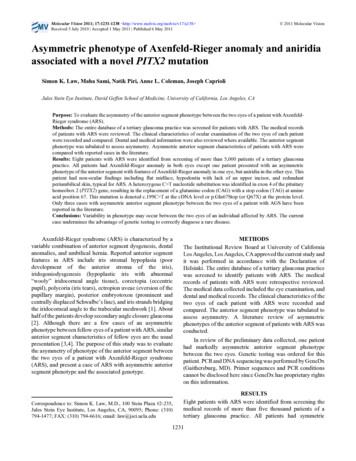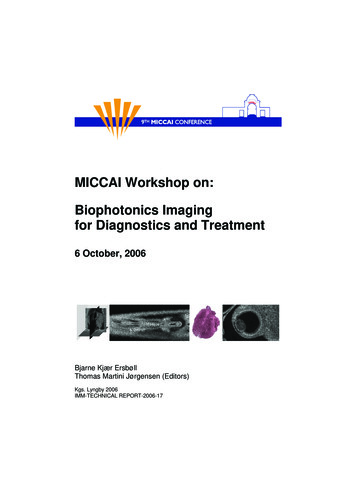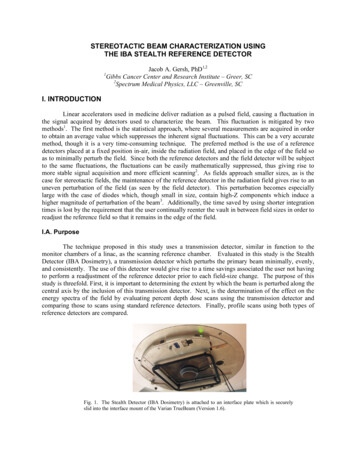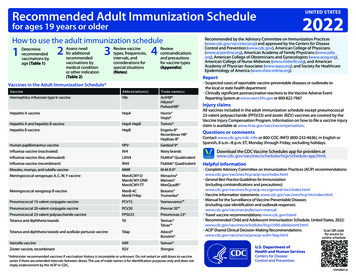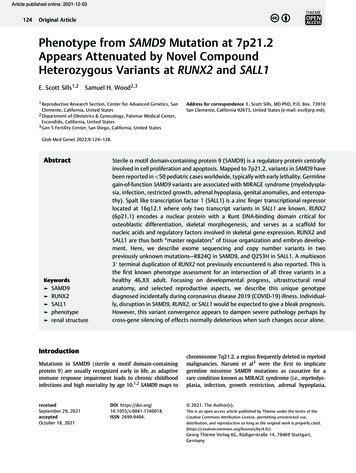
Transcription
Article published online: 2021-12-03THIEME124Original ArticlePhenotype from SAMD9 Mutation at 7p21.2Appears Attenuated by Novel CompoundHeterozygous Variants at RUNX2 and SALL1E. Scott Sills1,2Samuel H. Wood2,31 Reproductive Research Section, Center for Advanced Genetics, SanClemente, California, United States2 Department of Obstetrics & Gynecology, Palomar Medical Center,Escondido, California, United States3 Gen 5 Fertility Center, San Diego, California, United StatesAddress for correspondence E. Scott Sills, MD PhD, P.O. Box. 73910San Clemente, California 92673, United States (e-mail: ess@prp.md).Glob Med Genet 2022;9:124–128.AbstractKeywords SAMD9RUNX2SALL1phenotyperenal structureSterile α motif domain-containing protein 9 (SAMD9) is a regulatory protein centrallyinvolved in cell proliferation and apoptosis. Mapped to 7p21.2, variants in SAMD9 havebeen reported in 50 pediatric cases worldwide, typically with early lethality. Germlinegain-of-function SAMD9 variants are associated with MIRAGE syndrome (myelodysplasia, infection, restricted growth, adrenal hypoplasia, genital anomalies, and enteropathy). Spalt like transcription factor 1 (SALL1) is a zinc finger transcriptional repressorlocated at 16q12.1 where only two transcript variants in SALL1 are known. RUNX2(6p21.1) encodes a nuclear protein with a Runt DNA-binding domain critical forosteoblastic differentiation, skeletal morphogenesis, and serves as a scaffold fornucleic acids and regulatory factors involved in skeletal gene expression. RUNX2 andSALL1 are thus both “master regulators” of tissue organization and embryo development. Here, we describe exome sequencing and copy number variants in twopreviously unknown mutations—R824Q in SAMD9, and Q253H in SALL1. A multiexon3′ terminal duplication of RUNX2 not previously encountered is also reported. This isthe first known phenotype assessment for an intersection of all three variants in ahealthy 46,XX adult. Focusing on developmental progress, ultrastructural renalanatomy, and selected reproductive aspects, we describe this unique genotypediagnosed incidentally during coronavirus disease 2019 (COVID-19) illness. Individually, disruption in SAMD9, RUNX2, or SALL1 would be expected to give a bleak prognosis.However, this variant convergence appears to dampen severe pathology perhaps bycross-gene silencing of effects normally deleterious when such changes occur alone.IntroductionMutations in SAMD9 (sterile α motif domain-containingprotein 9) are usually recognized early in life, as adaptiveimmune response impairment leads to chronic childhoodinfections and high mortality by age 10.1,2 SAMD9 maps toreceivedSeptember 29, 2021acceptedOctober 18, 2021DOI https://doi.org/10.1055/s-0041-1740018.ISSN 2699-9404.chromosome 7q21.2, a region frequently deleted in myeloidmalignancies. Narumi et al3 were the first to implicategermline missense SAMD9 mutations as causative for arare condition known as MIRAGE syndrome (i.e., myelodysplasia, infection, growth restriction, adrenal hypoplasia, 2021. The Author(s).This is an open access article published by Thieme under the terms of theCreative Commons Attribution License, permitting unrestricted use,distribution, and reproduction so long as the original work is properly /)Georg Thieme Verlag KG, Rüdigerstraße 14, 70469 Stuttgart,Germany
Compound Variants in SAMD9, RUNX2, SALL1genital anomaly, and enteropathy). Such mutations werelater identified in 18% of inherited bone marrow failureand myelodysplasia cases.4 Regarding RUNX2, 200 differentmutations are known and most are seen with cleidocranialdysplasia, an autosomal dominant skeletal disorder including clavicular dysmorphia, increased head circumference,large fontanels, dental anomalies, short stature, and sometimes hand malformations.5 Spalt like transcription factor 1gene (SALL1) modulates onset and progression of humantumors, with variants now known to be associated withTownes-Brocks syndrome (i.e., anal, renal, limb, and earanomalies).6,7 While disruptions in SAMD9, RUNX2, andSALL1 have each been encountered separately, this reportis the first to present data on simultaneous variants in allthree.Clinical PresentationThis 18-year-old nonsmoking Caucasian female patientsought a second opinion consult regarding irregular menses.Academic progress was normal through high-school, withextracurricular activities including team sports and music.Accompanied by her mother, the patient appeared developmentally normal. Review of the prenatal chart was notablefor small for gestational age diagnosis in the third trimester.A genetic amniocentesis was normal. She was delivered bycesarean at 34 weeks’ gestation with birth weight 1,700 g.Sills, WoodPlacenta and umbilical cord were grossly normal. Bilateralchoanal atresia was diagnosed while in neonatal nursery, andwas successfully repaired by age 3 months.Recent medical history was unremarkable, although mildintermittent macrocytic anemia was occasionally noted oncomplete blood count and required no treatment. There was nohistory of electrolyte imbalance. Blood type was O þ . Menarche was at age 11, and normal ovarian, uterine, and cervicalanatomy was noted on a prior pelvic computed tomography.Six months before assessment, the patient was evaluatedelsewhere for persistent headache, low grade fever, diarrhea,emesis, and fatigue. Pregnancy test was negative. Coronavirusdisease 2019 (COVID-19) screen was initially negative, but oralvancomycin was started for Clostridium difficile which wasfound incidentally. Symptoms failed to resolve, and temperature increased to 39.7 C within 2 days when repeat COVID-19testing was positive. By now underweight, the patient wasadmitted to hospital where supportive care was provided in anisolation unit; oral vancomycin was adjusted to intravenousadministration. Three days later, her body mass index was 16.8and fever, diarrhea, and vomiting persisted. Proteinuria wasnoted with high serum creatinine (3.5 mg/dL). The diagnosiswas revised to COVID-19-associated multisystem inflammatory syndrome in children and the patient was transferred tointensive care unit (ICU). Next, vancomycin was discontinuedand remdesivir, azithromycin, dexamethasone, and intravenous immunoglobulin therapy began.8 While in ICU, theFig. 1 Transmission EM (1500x) view of renal tissue in a healthy 46,XX patient (age 17.5 years) with variants at SAMD9, RUNX2, and SALL1.Moderate focal global glomerulosclerosis is noted with segmental, irregular podocyte foot process effacement (arrow). Minimal basementmembrane thickening is also present with no significant endothelial edema. Immunofluorescence stains were negative for IgA, IgM, C1q, C3,kappa, lambda, fibrinogen or properdin. E, endothelial cell; GBM, glomerular basement membrane.Global Medical GeneticsVol. 9No. 2/2022 2021. The Author(s).125
126Compound Variants in SAMD9, RUNX2, SALL1Sills, WoodFig. 2 Schema for (A) variant at 7p21.2 SAMD9 (R824Q, red oval) NM 017654.3. Also shown are (B) multiexon RUNX2 duplication (blue oval) at6p21.1 (NM 001024630.3) and (C) variant at 16q12.1 SALL1 (Q253H, red oval) NM 002968.2. Of note, the newly discovered RUNX2 and SALL1variants were also present in proband’s mother.Global Medical GeneticsVol. 9No. 2/2022 2021. The Author(s).
Compound Variants in SAMD9, RUNX2, SALL1Sills, WoodTable 1 Summary of variant, protein, and genomic loci data present in 46,XX nonsyndromic SAMD9SAMD9RUNX2bSALL1DNA codingProtein productCoordinatesvar.effect2471 G AArg824Gln R824Q7:92732940 0.5ade novo[dup]759 A TParental datamat.dup.Gln253His Q253H16:51175374 4.08mat.var.Note: Variants reported are inherited as heterozygous/autosomal dominant. [dup] ¼ gene duplication.aCalculated protein variation effect analysis (PROVEAN).b3’ end duplication corresponds to arr[GRCh37] 6p21.1 (45459496 45515207)x3; same RUNX2 variant also identified in mother.patient’s erythrocyte sedimentation rate, C-reactive protein,and D-dimer level (all of which had been markedly elevated)began to decline. After a 15-day hospitalization, she wasdischarged home with a recommendation for outpatient renalbiopsy. This was completed along with a comprehensivegenetics panel. Her gastrointestinal symptoms resolved asactivities returned to normal, yet appetite remained low(thought to be COVID-19 sequela).Renal biopsy showed focal global and partial glomerulosclerosis, extensive foot process effacement, as well as mildinterstitial chronic inflammation ( Fig. 1). These changeswere regarded as consistent with recent COVID-19 infection.Exome sequencing identified three previously unknownvariants ( Fig. 2). Protein variation effect analysis9 wasperformed to estimate impact of amino acid substitutionon resultant protein bioactivity by delta alignment score.10The new SAMD9 variant was associated with a neutral effect( 0.5), although at SALL1 the variant was considered deleterious ( 4.08). Data were insufficient to develop an estimatefor the observed RUNX2 duplication (see Table 1). Analysisof mtDNA was normal.Genomic MethodologyGenomic DNA analysis was performed on cells sampled fromproband and both parents by buccal swab technique.11 Exomesand flanking splice junctions were captured using the IDTxGen Exome Research Panel v1.0 (Integrated DNA Technologies, Coralville, Iowa, United States). Massively parallel NextGen sequencing was done on an Illumina platform with 100bp paired-end reads. These were aligned to humangenome build GRCh37/UCSC hg19, and analyzed for sequencevariants using a custom-developed analysis tool.12 Additionalsequencing and variant interpretation were applied asdescribed previously.13 Variant classification criteria are available at GeneDx ClinVar page 957/).DiscussionOccurrence of SAMD9, RUNX2, and SALL1 mutation in humansis rare and information on these events mainly comes fromsmall series or case reports. Such data are valuable in providingimproved knowledge of gene function, particularly whenvariants are linked to specific phenotypes. Because SAMD9is an important regulatory protein crucial for normal development, it is unsurprising that variants in the responsible genewould yield an ‘orphan disease’ diagnoses in children and anunfavorable prognosis.14 Yet the full significance of any discovered variant is best appreciated by consideration of theentire genome. The convergence we report here is believed tobe the first instance where unique variants in SAMD9, RUNX2,and SALL1, all appear together. Accordingly, the phenotypeassessment adds to the understanding of these loci andsuggests how they may integrate to affect overall function.For our patient, the provisional diagnosis of MIRAGE syndrome seemed a poor fit given her overall clinical picture anddevelopmental history. While the association between SAMD9and MIRAGE syndrome is established,3 in our case a theory wasrequired to account for multiple missing elements. Priorreports on MIRAGE syndrome emphasized germline mutations, which were not proven here. Other possibilities includeda reversion mutation,15 or perhaps this variant in SAMD9 wasdifferentially operant on growth networks in multiple cellcontexts. The latter option would align with how alterations inthe Ras/mitogen-activated protein kinase (Ras/MAPK) pathway are considered to result in a range of pathologic conditionswith distinct clinical phenotypes.16,17 Cross-regulation byvariants elsewhere could not be dismissed, however. Attentionwas thus turned to RUNX2 and SALL1.Spalt-like transcription factors (SALLs) are highly conserved proteins that direct embryo development, apoptosis,angiogenesis, invasion, and metastasis.18 SALL1 is a transcription factor that mediates organogenesis and cell differentiation.19 Since gene expression is slowed when DNA isloosely packed, and SALL1 can dampen this action by influencing how tightly DNA is packed, the presence of this newSALL1 variant gained additional relevance. Moreover, aninstance where SALL1 influences gene operation is alreadyknown: its role as a tumor suppressor in breast cancer, whichis downregulated in estrogen receptor, progesterone receptor, and epidermal growth factor receptor-2 “triple negative”breast cancer patients.20Runt-related transcription factor 2 (RUNX2) regulatesosteogenesis and shares common signaling pathways inother tissue development. It is known to cooccur in severalepithelial and mesenchymal cancers, linked by multiplecancer-related proteins and microRNAs.21 Crucially, expertsin China discovered a role for SALL1 in differentiation ofmurine odontoblast lineages specifically with RUNX2.22 Ourdata support the observation of a coordinated regulatoryrole involving both RUNX2 and SALL1, offering furtherjustification for why all three genes should be consideredtogether.Global Medical GeneticsVol. 9No. 2/2022 2021. The Author(s).127
128Compound Variants in SAMD9, RUNX2, SALL1Sills, WoodSeveral issues remain open and thus limit this report. Forexample, although examination of renal ultrastructurerevealed nonspecific inflammatory changes, this may havebeen related to COVID-19 rather than any gene variantidentified here (i.e., comparison versus preinfection tissuesample was not possible). Imaging tests showing grosslynormal pelvic anatomy cannot forecast reproductive capacity into adulthood. And since our assessment was confined toexon sequencing only, any noncoding DNA mutation wouldbe missed by this technique.23,24 Nevertheless, the identification of these unexpected variants in SAMD9, RUNX2, andSALL1 in a clinical setting of normal development offers newinsights into how these loci may operate in concert.In summary, the pathogenic effects of the de novo variantin SAMD9 appear attenuated by changes in RUNX2 and SALL1operating concurrently. Careful longitudinal follow-up iswarranted and data from further assessments will bereported when available.8 Younis NK, Zareef RO, Fakhri G, Bitar F, Eid AH, Arabi M. COVID-19:91011121314Authors’ ContributionsE.S.S. organized the research plan, collated data, andassembled the work; S.H.W. contributed to study designand assisted with editing. Both authors read and approvedthe final manuscript.1516Conflict of InterestNone declared.17References1 Fischer I, Küchler J, Schaar C, et al. Generation of human induced234567pluripotent stem cell lines from 2 patients with MIRAGE syndrome. Stem Cell Res (Amst) 2021;54:102417Ramirez NJ, Posadas-Cantera S, Caballero-Oteyza A, CamachoOrdonez N, Grimbacher B. There is no gene for CVID - novelmonogenetic causes for primary antibody deficiency. Curr OpinImmunol 2021;72:176–185Narumi S, Amano N, Ishii T, et al. SAMD9 mutations cause a novelmultisystem disorder, MIRAGE syndrome, and are associatedwith loss of chromosome 7. Nat Genet 2016;48(07):792–797Ahmed IA, Farooqi MS, Vander Lugt MT, et al. Outcomes ofhematopoietic cell transplantation in patients with germlineSAMD9/SAMD9L mutations. Biol Blood Marrow Transplant2019;25(11):2186–2196Ott CE, Leschik G, Trotier F, et al. Deletions of the RUNX2 gene arepresent in about 10% of individuals with cleidocranial dysplasia.Hum Mutat 2010;31(08):E1587–E1593Kohlhase J, Taschner PEM, Burfeind P, et al. Molecular analysis ofSALL1 mutations in Townes-Brocks syndrome. Am J Hum Genet1999;64(02):435–445Chi D, Zhang W, Jia Y, Cong D, Hu S. Spalt-like transcription factor1 (SALL1) gene expression inhibits cell proliferation and cellmigration of human glioma cells through the Wnt/beta-Cateninsignaling pathway. Med Sci Monit Basic Res 2019;25:128–138Global Medical GeneticsVol. 9No. 2/2022 2021. The Author(s).18192021222324potential therapeutics for pediatric patients. Pharmacol Rep2021:1–19. Available at: 23/pdf/43440 2021 Article 316.pdfDong J, Zhang H, Mao X, et al. Novel biallelic mutations in MEI1:expanding the phenotypic spectrum to human embryonic arrestand recurrent implantation failure. Hum Reprod 2021;36(08):2371–2381Choi Y, Sims GE, Murphy S, Miller JR, Chan AP. Predicting thefunctional effect of amino acid substitutions and indels. PLoS One2012;7(10):e46688Kanokwongnuwut P, Martin B, Taylor D, Kirkbride KP, Linacre A.How many cells are required for successful DNA profiling?Forensic Sci Int Genet 2021;51:102453Retterer K, Scuffins J, Schmidt D, et al. Assessing copy numberfrom exome sequencing and exome array CGH based on CNVspectrum in a large clinical cohort. Genet Med 2015;17(08):623–629Retterer K, Juusola J, Cho MT, et al. Clinical application of wholeexome sequencing across clinical indications. Genet Med 2016;18(07):696–704Zheng RF, Su Z, Wang L, Zhao X, Li ZG. [MIRAGE syndrome causedby variation of sterile alpha motif domain-containing protein 9gene]. Zhonghua Er Ke Za Zhi 2021;59(05):417–419Shima H, Koehler K, Nomura Y, et al. Two patients with MIRAGEsyndrome lacking haematological features: role of somatic second-site reversion SAMD9 mutations. J Med Genet 2018;55(02):81–85Simanshu DK, Nissley DV, McCormick F. RAS proteins and theirregulators in human disease. Cell 2017;170(01):17–33Wong JC, Bryant V, Lamprecht T, et al. Germline SAMD9 andSAMD9L mutations are associated with extensive genetic evolution and diverse hematologic outcomes. JCI Insight 2018;3(14):e121086Ma T, Shi S, Jiang H, et al. A pan-cancer study of spalt-liketranscription factors 1/2/3/4 as therapeutic targets. Arch BiochemBiophys 2021;711:109016Vodopiutz J, Zoller H, Fenwick AL, et al. Homozygous SALL1mutation causes a novel multiple congenital anomaly-mentalretardation syndrome. J Pediatr 2013;162(03):612–617Ma C, Wang F, Han B, et al. SALL1 functions as a tumorsuppressor in breast cancer by regulating cancer cell senescenceand metastasis through the NuRD complex. Mol Cancer 2018;17(01):78Zhu Y, Ortiz A, Costa M. Wrong place, wrong time: Runt-relatedtranscription factor 2/SATB2 pathway in bone development andcarcinogenesis. J Carcinog 2021;20:2Lin Y, Xiao Y, Lin C, et al. SALL1 regulates commitment ofodontoblast lineages by interacting with RUNX2 to remodelopen chromatin regions. Stem Cells 2021;39(02):196–209Vaz-Drago R, Custódio N, Carmo-Fonseca M. Deep intronicmutations and human disease. Hum Genet 2017;136(09):1093–1111Moles-Fernández A, Domènech-Vivó J, Tenés A, Balmaña J, Diez O,Gutiérrez-Enríquez S. Role of splicing regulatory elements and insilico tools usage in the identification of deep intronic splicingvariants in hereditary breast/ovarian cancer genes. Cancers(Basel) 2021;13(13):3341
Escondido, California, United States 3Gen 5 Fertility Center, San Diego, California, United States Glob Med Genet 2022;9:124-128. Address for correspondence E. Scott Sills, MD PhD, P.O. Box. 73910 San Clemente, California 92673, United States (e-mail: ess@prp.md). Introduction Mutations in SAMD9 (sterile α motif domain-containing
